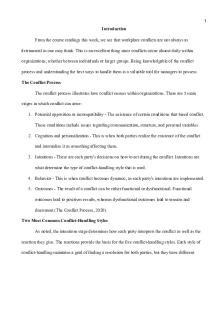BUS 5113 UNIT 4 Breakthrough Improvement Plan Case PDF

| Title | BUS 5113 UNIT 4 Breakthrough Improvement Plan Case |
|---|---|
| Author | Debra Winters |
| Course | Managerial Accounting |
| Institution | University of the People |
| Pages | 4 |
| File Size | 112.5 KB |
| File Type | |
| Total Downloads | 46 |
| Total Views | 153 |
Summary
BUS 5113 UNIT 6 Myths and Realities of Teamwork...
Description
Running Head: BREAKTHROUGH IMPROVEMENT PLAN CASE
Breakthrough Improvement Plan Case
This improvement plan addresses the case study of a local processing plant experiencing low-quality mail sortation and production performance of 93%, which is beneath the breakthrough goal of 98% delivery point sequence. This plan analyzes communication issues and communication channels bypassed and implementation plan recommendations. Communication Issues The low-quality production of mail unproperly sequenced and sorted, and delayed or delivered in error. The overall unacceptable production and amount of mail returns were largely a result of poor to miserable communication between upper, middle, and floor level management and interfacing groups to production.
Machine performance was sub-standard, and the maintenance team remained uninformed.
Management neglected to provide employees with essential performance
feedback for fear of union intrusion; employees worked with no understanding of what they were doing right or wrong in their jobs.
In response to rising customer complaints, senior management summoned middlemanagement leaders but neglected to invite floor managers into the process. They missed the opportunity to hear directly from the leaders in the middle of production and work floor chaos. Page 1
When senior management handed down an improvement plan instructions but no one on the front line understood what they were trying to accomplish. With continued failure, employee motivation and morale diminished.
The communication channels missed were the opportunity for upper management to talk directly to the floor leaders and workers to engage them directly in developing and working an improvement plan, learn what the issues are for the employees and the processes they use. It was also a missed opportunity to collect ideas and solutions directly from the workers (Englestad, 2017). Implementing an Improvement Plan To implement a new improvement plan, the senior leaders must employ a brand new approach: 1. Conduct all-hands meetings that include all levels of management and floor employees as a “kick-off” to inform all of current performance statistics and the goal for operations. Organize teams from the bottom up to identify problem areas and solutions to problems. Line and middle managers report upwards to executives. 2. Upper and middle-level managers then develop a strategy and plan to communicate with line managers and workers. Adjustments and corrections per feedback are made before rolling out the plan. 3. More all-hands meetings communicate the plan to all to initiate the improvement plan kick-off. Plan a party to make the whole event positive and exciting. Effective Program Implementation Page 2
Effective program implementation depends on the continuance of open, transparent communication. Employees need to be aware of the progress in productivity and be rewarded with public praise and incentives accordingly. Progress and milestones should be posted in break rooms and common areas. Regular staff meetings and tools like surveys will gather feedback and success or problems as the plan progresses. Finally, employees must have performance reviews that celebrate their successes or serve to give them feedback and tools to improve (Communication in Organizations, n.d.). Conclusion The failure to succeed for this mailing plant was due to the lack of communication and engagement of employees at all levels. The workers on the line are truly the experts in operations at the production level and know first-hand what the issues are and have ideas for improvement in processes and the environment in which they work. People need to feel involved and important in all aspects of their life. These senior leaders will succeed if they utilize the talent and ideas at all levels (Communication in Organizations, n.d.).
Page 3
References Communication in organizations. (n.d.). Reference for business. Retrieved from http://www.referenceforbusiness.com/encyclopedia/Clo-Con/Communication-inOrganizations.html Engelstad, F. (2017). Strategic communication and institutional change. In Engelstad F., Larsen H., Rogstad J., Steen-Johnsen K., Polkowska D., Dauber-Griffin A., et al. (Eds.), Institutional Change in the Public Sphere: Views on the Nordic Model(pp. 139159). Berlin/Boston: De Gruyter. Retrieved from http://www.jstor.org/stable/j.ctvbkk05k.10
Page 4...
Similar Free PDFs

BUS 5113 - Unit 6 Discussion
- 4 Pages

BUS 5113 - Unit 5 Discussion
- 3 Pages

BUS 5113 Discussion Unit 7
- 3 Pages

BUS 5113 Portfolio Unit 3 Answer
- 5 Pages

BUS 5113 Portfolio 2
- 3 Pages

BUS 1104 WA Unit 4
- 5 Pages

Behavior Improvement Plan Eric
- 5 Pages
Popular Institutions
- Tinajero National High School - Annex
- Politeknik Caltex Riau
- Yokohama City University
- SGT University
- University of Al-Qadisiyah
- Divine Word College of Vigan
- Techniek College Rotterdam
- Universidade de Santiago
- Universiti Teknologi MARA Cawangan Johor Kampus Pasir Gudang
- Poltekkes Kemenkes Yogyakarta
- Baguio City National High School
- Colegio san marcos
- preparatoria uno
- Centro de Bachillerato Tecnológico Industrial y de Servicios No. 107
- Dalian Maritime University
- Quang Trung Secondary School
- Colegio Tecnológico en Informática
- Corporación Regional de Educación Superior
- Grupo CEDVA
- Dar Al Uloom University
- Centro de Estudios Preuniversitarios de la Universidad Nacional de Ingeniería
- 上智大学
- Aakash International School, Nuna Majara
- San Felipe Neri Catholic School
- Kang Chiao International School - New Taipei City
- Misamis Occidental National High School
- Institución Educativa Escuela Normal Juan Ladrilleros
- Kolehiyo ng Pantukan
- Batanes State College
- Instituto Continental
- Sekolah Menengah Kejuruan Kesehatan Kaltara (Tarakan)
- Colegio de La Inmaculada Concepcion - Cebu








